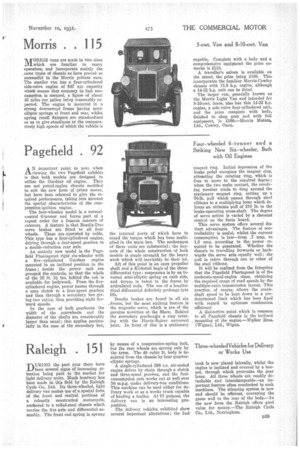Pagefield . 92
Page 29

If you've noticed an error in this article please click here to report it so we can fix it.
AN important point to note when viewing the two Pagefield exhibits is that both models are designed to utilize the Gardner oil engine. They are not petrol-engine chassis modified to suit the new form of prime mover, but have been schemed to give the required performance, taking into account the special characteristics of the compression-ignition engine.
The four-wheeled model is a normalcontrol 6-tonner and forms part of a repeat order for a famous concern of caterers. A feature is that Bendix-Duo servo brakes are fitted to all four wheels. These are !operated by cable. This type has a four-cylindered engine, driving through a four-speed gearbox to a double-reduction rear axle.
An entirely new model is the Pagefield Plantagenet rigid six-wheeler with a fivecylindered Gardner engine mounted in an inclined position in the frame ; beside the power unit are grouped the controls, so that the whole of the 22 ft. 3i ins, behind the cab is available for bodywork. From the fivecylindered engine, power passes through a cone clutch to a four-speed gearbox and then through a secondary box giving two ratios, thus providing eight forward speeds.
In the case of both gearboxes the width of the gearwheels and the diameter of the shafts are considerably larger than usual; this applies particularly in the case of the secondary box, the internal parts of which have to stand the torque which has been multiplied in the main box. The anchorages of these units are substantial; the keynote of the whole construction of both models is ample strength for the heavy work which will inevitably be their lot.
Aft of this point is an open propeller shaft and a Kirkstall bogie of the threedifferential type; suspension is by an inverted semi-elliptic spring on each side, and torque is taken to the frame by articulated rods. The use of a longitudinal differential definitely prolongs tyre life.
Bendix brakes are found in all six , drums, but the most striking feature is the magnetic servo, which is one of the genuine novelties at the Show. Behind the secondary gearboxItis a ring rotating with the tfardy-Spicer universal joint. In front of this is a stationary
magnet ring. Initial depression of the brake pedal energizes the magnet ring, attracting the rotating ring, which is free to move to the required degree ; when the two make contact, the revolving member tends to drag around the stationary magnet ring, setting up a 70-lb. pull which passes through steel ribbons to a multiplying lever which delivers an ultimate pull of 210 lb. to the brake-operating cross-shaft. The degree of servo action is varied by a rheostat control on the facia board.
This servo system offers several distinct advantages. The feature of controllability is useful, whilst the current consumption is low—from .7 amp. to 1.3 amp, according to the power required to be generate& Whether the chassis he travelling forwards or backwards the servo acts equally well; the pull is taken through one or other of the steel ribbons.
It will be realized from the foregoing that the Pagefield Plantagenet is of the moderate-speed-engine class, obtaining the required range of road speeds by the multiple-ratio transmission layout. This practice, of course, allows the crankshaft speed to be kept down to a predetermined limit which has been fixed with regard to optimum combustion efficiency A distinctive point which is common to all Pagefield chassis is the inclined , mounting of the engine.—Walker Bros. (Wigan), Ltd., Wigan.
















































































































































